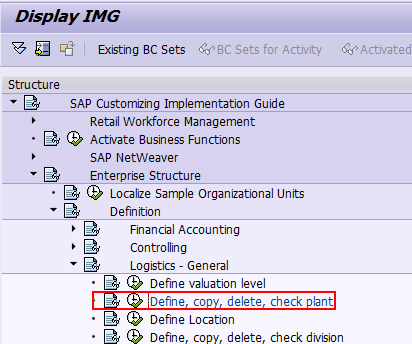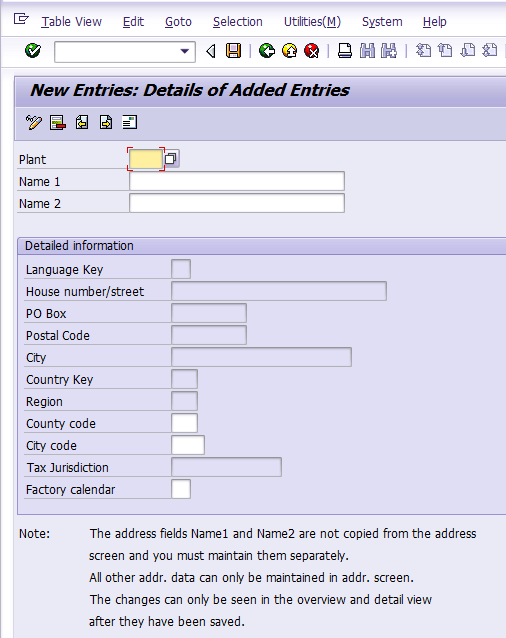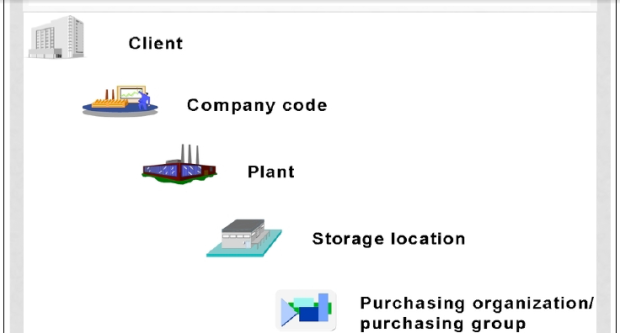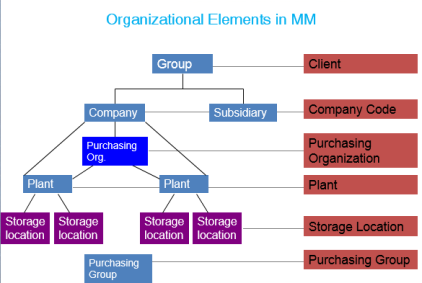Define Plant
Plant
As a part of the Logistics Organizational Structure, Plants are defined in SAP. The ‘Plant’ is an operating area or a branch or a location within a company. Each ‘Plant’ is assigned to a single ‘company code’. A ‘company code’ can have several ‘Plants’.
Before setting up new plant, certain other settings need to be defined:
Factory calendar
A factory calendar identifies the workdays, public holidays, and company holidays. The SAP system is delivered with some factory calendars, but a new factory calendars can be configured on a companys schedule.
Country Key
A country key is required to define a plant. The system is delivered with country keys, and new country codes need to be configured if athey are not in the system.
Region Keys
A region code is required along with the country code. The region is defined as a state or province associated with a country
Create a new plant
A four-character string defines the plant field.
Menu path : Implementation Guide for R/3 Customizing (IMG) -> Enterprise Structure -> Definition -> Logistics general -> Define, copy, delete, check plant.
Step 1 . Go to SPRO

Step 2. Double click at Define Plant

Step 3. Click at New Entries button

Step 4. Key in your new Plant here. Afterwards click at save icon to apply your new configuration.

Organizational Structure in Procurement Process

Client
The client is a unit within an SAP system that is self-contained both in legal and organizational terms and in terms of data, with separate master records and an independent set of tables. From a business viewpoint, the client represents a corporate group, for example.
The client is the highest hierarchical level in the SAP system. Specifications or data that you make and enter at this level apply to all company codes and all other organizational units. Therefore, you do not have to enter the specifications and data at client level more than once in the system. This ensures a uniform data status.
Access authorization is assigned on a client-specific basis. A user master record must be created for every user in the client in which he or she wishes to work. If the Client field has not been prepopulated, each user must specify a client key when logging onto an SAP system. In this way, the user specifies the client in which he or she wishes to work. All user input is stored, separated by client.
The processing and evaluation of data is likewise carried out on a client-specific basis. A client is uniquely defined in the system by a three-digit numeric key.
Company Code
The company code is the smallest organizational unit of external accounting for which a complete, self-contained bookkeeping system can be replicated. This includes the entry of all events that require posting to the accounts and the creation of a complete audit trail for balance sheets and profit and loss statements.
A company code represents an independent unit producing its own balance sheet, for example, a company within a corporate group (client).
You can set up several company codes in one client in order to thus keep separate sets of financial books. You can use a special Customizing function to copy a company code. In the process, company-code-dependent specifications are adopted for your new company code.
A company code is defined in the system by means of a four-character alphanumeric key that is unique in the client.
Plant
The definition of a plant depends on its use. From a materials-management view a plant can be defined as a location that holds valuated stock.
A plant may represent a variety of entities within a firm, such as:
– Production facility
- Distribution center
– Regional sales office
– Corporate headquarters
- Maintenance location
When creating a new plant, you can use the plant copy function. In the process, all entries in the plant table and all Customizing and system tables that depend on it, and in which the plant occurs as the key, are taken into account.
A plant is defined in the system by means of a four-character alphanumeric key that is unique in the client.
Storage Location
The storage location is an organizational unit that facilitates the differentiation of stocks of materials within a plant. Inventory management on a quantity basis is carried out in the plant at storage location level. The physical inventory is also carried out at this level.
A storage location is defined by means of a four-character alphanumeric key that is unique in the plant.
Purchasing Group
A purchasing group is a key for a buyer or a group of buyers who is/are responsible for certain purchasing activities. Internally, the purchasing group is responsible for the procurement of a material or class of materials.
Externally, it is the principal channel for an enterprise’s dealings with its vendors. The purchasing group is not aligned to other units in the company structure.
Purchasing Organization
The purchasing organization is an organizational unit within logistics that subdivides the enterprise according to the purchasing requirements. A purchasing organization procures materials or services, negotiates conditions of purchase with vendors, and assumes responsibility for these transactions.
You can incorporate purchasing into the company structure by assigning the purchasing organization to a company code and to plants. This means that you can take into account whether purchasing is organized on a centralized or decentralized basis in your company. You can have a combination of these two organizational forms.
You can assign several purchasing organizations to one company code. However, a certain purchasing organization can only belong to one company code. You can decide not to assign the purchasing organization to a company code (cross-company-code purchasing).
There is an m:n relationship between purchasing organizations and plants. In other words, you can assign several plants to one purchasing organization, and one plant to several purchasing organizations.
The different assignment options between company code, plant, and purchasing organization yield the following categories of purchasing organization.
In plant-specific procurement, a purchasing organization is responsible for procuring materials for just one plant.

Recent Comments